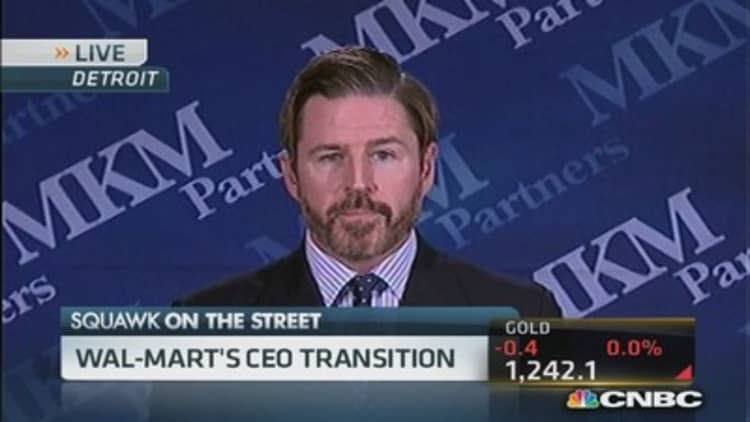Cold weather and a reduction in food stamp benefits aren't the only reasons behind Wal-Mart's lowered fourth-quarter forecast.
The big-box discounter is in need of a bricks-and-mortar makeover, analysts said. To resonate with today's shopper, Wal-Mart needs to move its stores closer to major population centers, shrink the square footage of its superstores and shutter about 100 underperforming U.S. locations, they suggest.
(Read more: A 'tsunami' of store closings seen hitting retail)
"High sustained transportation costs and broader consumables distribution appear to be reshaping consumer shopping behavior," Credit Suisse analyst Michael Exstein said in a research note on Wednesday. "Wal-Mart and Target have been slow to react thus far, but we think the broader trend will call for the rollout of smaller 'big boxes.' "
Wal-Mart said Friday its fourth-quarter earnings would come in "at or slightly below the low end" of its $1.60 to $1.70 per share projection. The retailer also said that sales will come in slightly negative to the guidance it provided in its third-quarter report, which called for U.S. same-store sales to be relatively flat.
As of Dec. 31, Wal-Mart said that it operates 4,177 stores in the U.S., excluding its Sam's Club warehouse club footprint. Among them are 3,275 supercenters, which average about 182,000 square feet.
This is simply too many stores, said Belus Capital Advisors analyst Brian Sozzi.
(Read more: Wal-Mart guides earnings lower)
Not only does Wal-Mart need to shutter about 100 of its stores that have consistent same-store sales losses of more than 3 percent, it also needs cut the square footage of its supercenters in half, Sozzi said. In a show of good faith to Wall Street, the retailer needs to announce plans to shutter 50 stores in its February earnings announcement, to show that management finally understands the problem, he said.
"Do you need a bike section when you can go to Walmart.com? No," he said.
Another issue is where the retailer's stores are located. Charles Fishman, author of "The Wal-Mart Effect," said that Wal-Mart's expansion strategy under founder Sam Walton was to open stores on inexpensive land in communities that other retailers assumed were too small to support a large store.
As a result of these size and expense considerations, many of its locations are based outside of immediate population centers.
But with 2013 gas prices at an average of $3.58 a gallon—compared with the $1 to $1.25 price that dominated the late 1980s and 1990s, when Wal-Mart rolled out much of its store base—it no longer makes sense for shoppers to drive long distances to get products that they can order online, or get at a nearby drugstore or dollar store.
(Read more: Wal-Mart test: Buy food online, pick up in-store)
Paired with higher fuel prices, declining discretionary dollars also are pushing more consumers to fill up on items as the need arises during the week, as opposed to making fewer trips and stocking up on everything they need at the beginning of the week.

"It appears increasingly uneconomic for the customer to drive 20 to 30 miles round trip to a supercenter to save a marginal amount on consumable goods—particularly when consumables, including food, are becoming more broadly distributed," Exstein said.
Exstein, who upgraded his rating on the retailer to "outperform" from "neutral" this week, said he expects that newly appointed CEO Doug McMillon will tackle the issue and accelerate its plan to add small-store formats. Exstein pointed to an announcement made at Wal-Mart's October analyst day, when it disclosed plans to quicken the expansion of its neighborhood markets, which are about a quarter the size of its supercenters. In January, Wal-Mart opened 12 new neighborhood markets, which is the same number as they averaged for an entire quarter last year, Fishman said.
This is a change from the mid-2000s, when the retailer would open an average of five stores a week, and 80 percent of them were supercenters, Fishman said.
But the problem, Sozzi said, is that Wal-Mart isn't closing its megastores when it opens a smaller format. It's simply adding to its store count.
"There's just too many Wal-Marts," he said.
In response to a request for comment, Wal-Mart pointed CNBC toward its press release, and said it would have additional details on results in its earnings release on Feb. 20.
—By CNBC's Krystina Gustafson. Follow her on Twitter @KrystinaGustafs.


